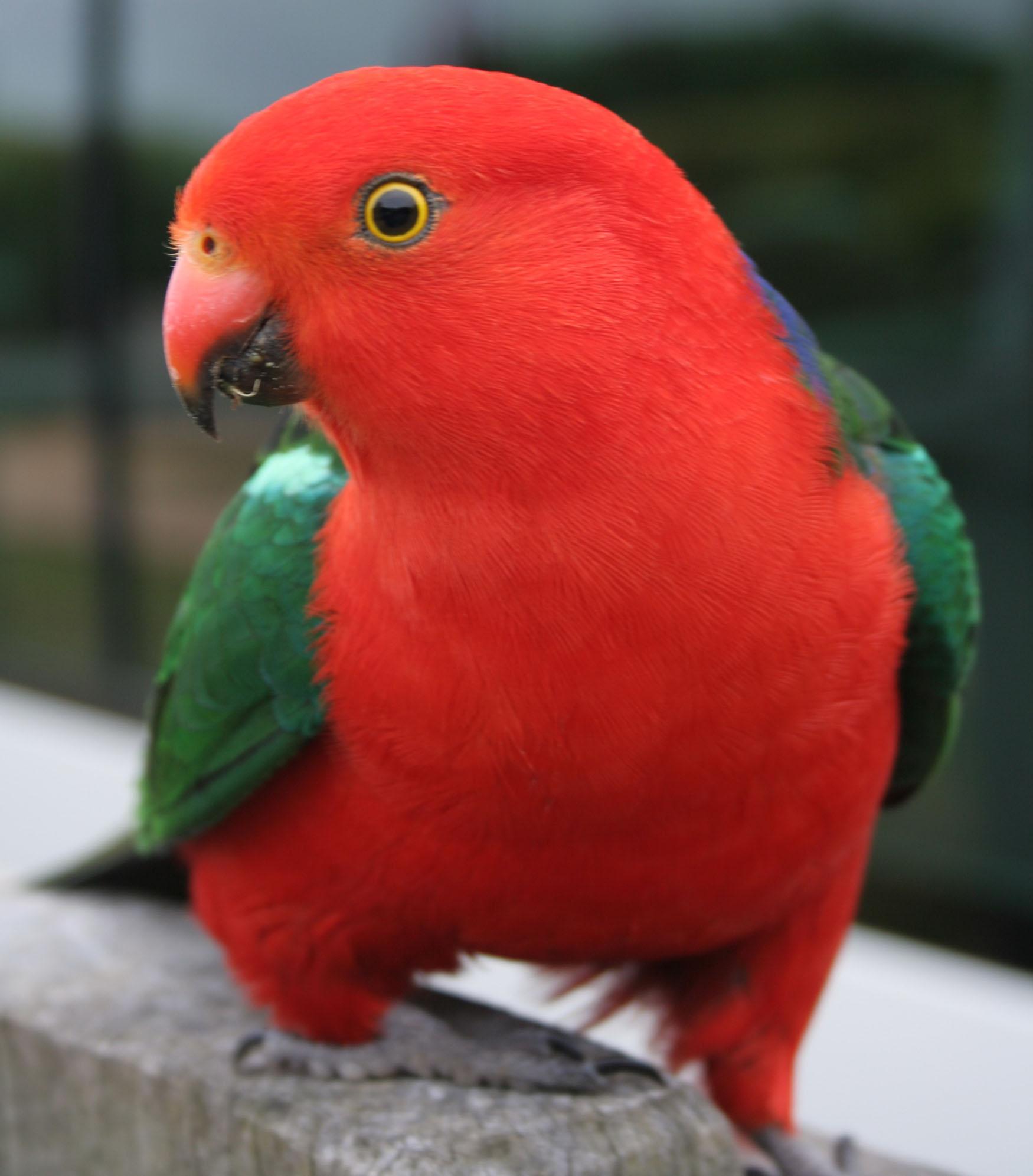Moluccan King Parrot Information
Source(Wikipedia)
The Moluccan King Parrot (Alisterus amboinensis) is a parrot that is endemic to Peleng Island, Maluku and West Papua in Indonesia. It is sometimes referred to as the Ambon King Parrot or Amboina King Parrot,[2] but this is potentially misleading, as it is found on numerous other islands than Ambon. The male and female are similar in appearance, with a predominantly red head and underparts, green wings (blue in one subspecies), and blue back and tail. Six subspecies are recognised, but only a few of these are regular in aviculture. In the wild, it inhabits rainforests and feeds on fruits, berries, seeds and buds.
Contents [show]
[edit]Taxonomy
Image of a colour lithograph of a Moluccan King Parrot produced by William John Swainson in the first volume of Zoological Illustrations
Described by Linnaeus in 1766,[3] the Moluccan King Parrot is one of three species collectively known as king parrots found in Australia, Papua New Guinea, and Indonesia.[4] It has six subspecies:[3]
Alisterus amboinensis (Linnaeus, 1766)
Alisterus amboinensis amboinensis (Linnaeus, 1766) is the nominate subspecies and found on Ambon and Seram.[5]
Alisterus amboinensis buruensis (Salvadori, 1876) is found on Buru in central Maluku.[5]
Alisterus amboinensis dorsalis (Quoy & Gaimard, 1830) is found in West Papua. The red plumage is slightly darker in this subspecies.[5]
Alisterus amboinensis hypophonius (S. Müller, 1843) has all blue wings and is endemic to Halmahera in northern Maluku.[5]
Alisterus amboinensis sulaensis (Reichenow, 1881) is found on the Sula Islands.[5]
Alisterus amboinensis versicolor Neumann, 1939 is endemic to the island of Peleng of the Banggai Islands.[5]
[edit]Description
At the bird park in Taman Mini Indonesia Indah
An adult Moluccan King Parrot measures 35–40 cm (14 in) in length and has a red head and chest, outer wings dull green (except in subspecies hypophonius, where blue), mantle, lesser wing coverts and tail-coverts dark purple-blue.[4][6] Tail darker blackish blue, irises orange, and the legs are dark grey.[5] The lower mandible is blackish, and the upper mandible is orange-red with a blackish tip, except in the subspecies buruensis, where the entire bill is blackish.[4] Unlike the other species of king parrots, the Moluccan King Parrot does not display sexual dimorphism; that is, the sexes have similar plumage.[4] Juvenile birds have a dark-brown bill tipped paler, greenish mantle, dark brown irises and red-tips to lateral tail feathers.[4] Birds reach maturity in one year.[6][7]
[edit]Behavior
Encountered alone or in pairs, occasionally in small groups, it mainly frequents dense cover in the lower and mid-levels of forests.[8] It is inconspicuous and rather quiet, except in flight.[8] It consumes fruit, berries, seeds and buds.[5][7] Nesting takes place in a tree-hollow.[6] The breeding season begins in February and March, although breeding has not been observed in the wild, in captivity the clutch consists of two eggs which are incubated for 19 days. After hatching the chicks are ready to fledge at nine weeks old.[9]
[edit]Habitat and status
At Brevard Zoo.
The Moluccan King Parrot inhabits rainforests, but sometimes enters nearby plantations and gardens.[6] Exceptionally, it occurs at altitude up to 2100 m,[6] but more commonly below 1200 m (New Guinea)[10] or 1600 m (Maluku).[8]
The Moluccan King Parrot is generally uncommon due to habitat loss and capture for the parrot trade,[6] but remains locally common at least on the Sula Islands, Halmahera and Buru.[8] Overall the species is not believed to be in immediate danger, and consequently is listed as Least Concern by BirdLife International and IUCN.[1] As most parrots, the Moluccan King Parrot is listed in Appendix II of CITES.
[edit]Aviculture
Until recently only the subspecies amboinensis and hypophonius were seen regularly seen in aviculture, but buruensis and dorsalis are now also present, at least in zoos.[11][12] It has regularly been bred in captivity,[7] for example in Denmark.[13]
[edit]References
^ a b BirdLife International (2012). "Alisterus amboinensis". IUCN Red List of Threatened Species. Version 2012.1. International Union for Conservation of Nature. Retrieved 16 July 2012.
^ Moluccan King-Parrot. Mangoverde. Accessed 19-06-2009
^ a b "Zoological Nomenclature Resource: Psittaciformes (Version 9.024)". www.zoonomen.net. 2009-05-30.
^ a b c d e Forshaw (2006). plate 49.
^ a b c d e f g h Forshaw, Joseph M. and Cooper, William T. (1978). Parrots of the World (2nd ed.). Melbourne: Landsdowne Editions. pp. 218–19. ISBN 0-7018-0690-7.
^ a b c d e f Juniper, T., & M. Parr (1998). A Guide to the Parrots of the World. Pica Press. pp. 327–328. ISBN 1-873403-40-2.
^ a b c Lexicon of Parrots, online version. Arndt Verlag. Accessed 19-06-2009
^ a b c d Coates, B. J., & K. D. Bishop (1997). A Guide to the Birds of Wallacea. Dove Publications Pty. Ltd. pp. 342–343. ISBN 0-9590257-3-1.
^ Collar N (1997) "Family Psittacidae (Parrots)" in Handbook of the Birds of the World Volume 4; Sandgrouse to Cuckoos (eds del Hoyo J, Elliott A, Sargatal J) Lynx Edicions:Barcelona. ISBN 84-87334-22-9
^ Beehler, B., T. K. Pratt, & D. A. Zimmerman (1986). Birds of New Guinea. Princeton University Press. p. 122. ISBN 0-691-08385-1.
^ Buru king parrot. Zootierliste.de. Accessed 19-06-2009
^ Salawati king parrot. Zootierliste.de. Accessed 19-06-2009
^ Vriends MM, Earle-Bridges M, Heming-Vriends TM (1992). The New Australian Parakeet Handbook. Barron's. p. 137. ISBN 812047397
Moluccan King Parrot

Moluccan King Parrot

Moluccan King Parrot

Moluccan King Parrot

Moluccan King Parrot

Moluccan King Parrot

Moluccan King Parrot

Moluccan King Parrot

Moluccan King Parrot

Moluccan King Parrot

Moluccan King Parrot
No comments:
Post a Comment